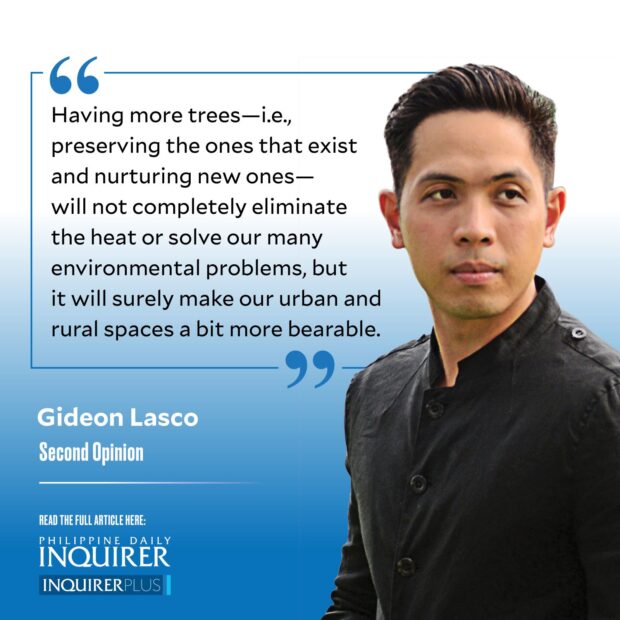More trees: Antidote to our heat problem
The heat nowadays is debilitating; the word that comes to mind is not just “init,” but “banas,” which, like the heat index, also factors in humidity.
For most, the heat is just an inconvenience—one that causes sweat and discomfort; one that drives people to escape to the refuge of air-conditioned malls. But for some, it can be a health threat; in one city alone—Cabuyao, Laguna—83 students were supposed to have been hospitalized last March 23 due to heat exhaustion during fire and earthquake drills.
Some may write off the heat as an inevitable part of the season, but there is nothing “natural” about the heat that we experience. In the first place, the world is warmer today than even just a decade ago; according to the 2022 Global Climate Report from the NOAA National Centers for Environmental Information, “The 10 warmest years in the 143-year record have all occurred since 2010, with the last nine years (2014–2022) ranking as the nine warmest years on record.” And there is overwhelming evidence that this is caused by human activity.
More than the climate crisis itself, however, the very fact that we’re exposed to so much heat is a result of living in environments where there are very few trees. Cities are particularly notorious for forming “heat islands,” in which roads, buildings, rooftops, and other artificial surfaces absorb and emit heat. Add to that the heat from vehicles, and walking by the road or riding a jeepney becomes even more unbearable.
“To avoid this, because this is preventable, we advise the public to avoid going out in the sun, especially when the sun is too hot and always wear sun protection,” Department of Health officer in charge Maria Rosario Vergeire was quoted as saying. The Department of Education, for its part, said that schools may suspend classes if they think it is necessary—amid calls to revert to the old academic calendar that avoided what we refer to as our “summer.”
It is a pity that the sun itself will limit people’s outdoor exposure which is already limited to begin with—especially in the aftermath of a pandemic that has caused many to fear the outdoors. It’s also a pity that air conditioning—our default solution—is only readily accessible to those who can afford it; I have seen households in Valenzuela and Pasay when several electric fans are not enough to cool one’s living room.
Alas, in many parts of our country, the ability to control temperature is a direct function of one’s income.
If our treelessness is a big reason for the heat, however, then there is one obvious—and very sustainable—antidote to our heat problem: More trees.
The cooling effect of trees, as it turns out, operates at multiple levels. The most obvious is that they provide shade, which is why, when I’m in Diliman, walking around the Academic Oval, under the acacia, is quite tolerable any time of the day. More than just serving as big umbrellas, trees either absorb solar energy or reflect it back to the atmosphere.
But there’s also evapotranspiration, which, simply put, is the process of absorbing water (via roots) and releasing it (via leaves and other plant surfaces), dissipating some of the atmospheric heat in the process of facilitating evaporation, cooling the environment in the same way that sweating cools down the body.
Trees also reduce energy use, which further helps reduce the heat. Air conditioners and fans may cool us but they also release “waste heat”; if we rely on them less, we produce less of this heat. And of course the more energy we use, the more we hasten global warming.
Which brings me to the trees’ longer-term cooling effect: They sequester carbon dioxide and can help avert the climate crisis.
The cooling effect of trees leads to other environmental benefits other than reducing heat. Just to give one example, they enable walkability—which reduces the demand for cars, which also reduces the heat.
Alas, trees are often seen as roadblocks to progress and are cut to give way to what some people insist as “development.” Where have all the tree-lined highways gone; roads like Pili Drive in Los Baños? And where are the forested parks that, in cities around the world, serve as giant air conditioners?
Worse, many think of trees as replaceable; that it’s okay to cut them as long as we replace them with seedlings. The fact is that an ancient tree—with its majestic trunk and extensive root system—offers so much more cooling effect than young ones and it will takes decades, if not centuries to replace.
Having more trees—i.e., preserving the ones that exist and nurturing new ones—will not completely eliminate the heat or solve our many environmental problems, but it will surely make our urban and rural spaces a bit more bearable.
—————-
glasco@inquirer.com.ph





















